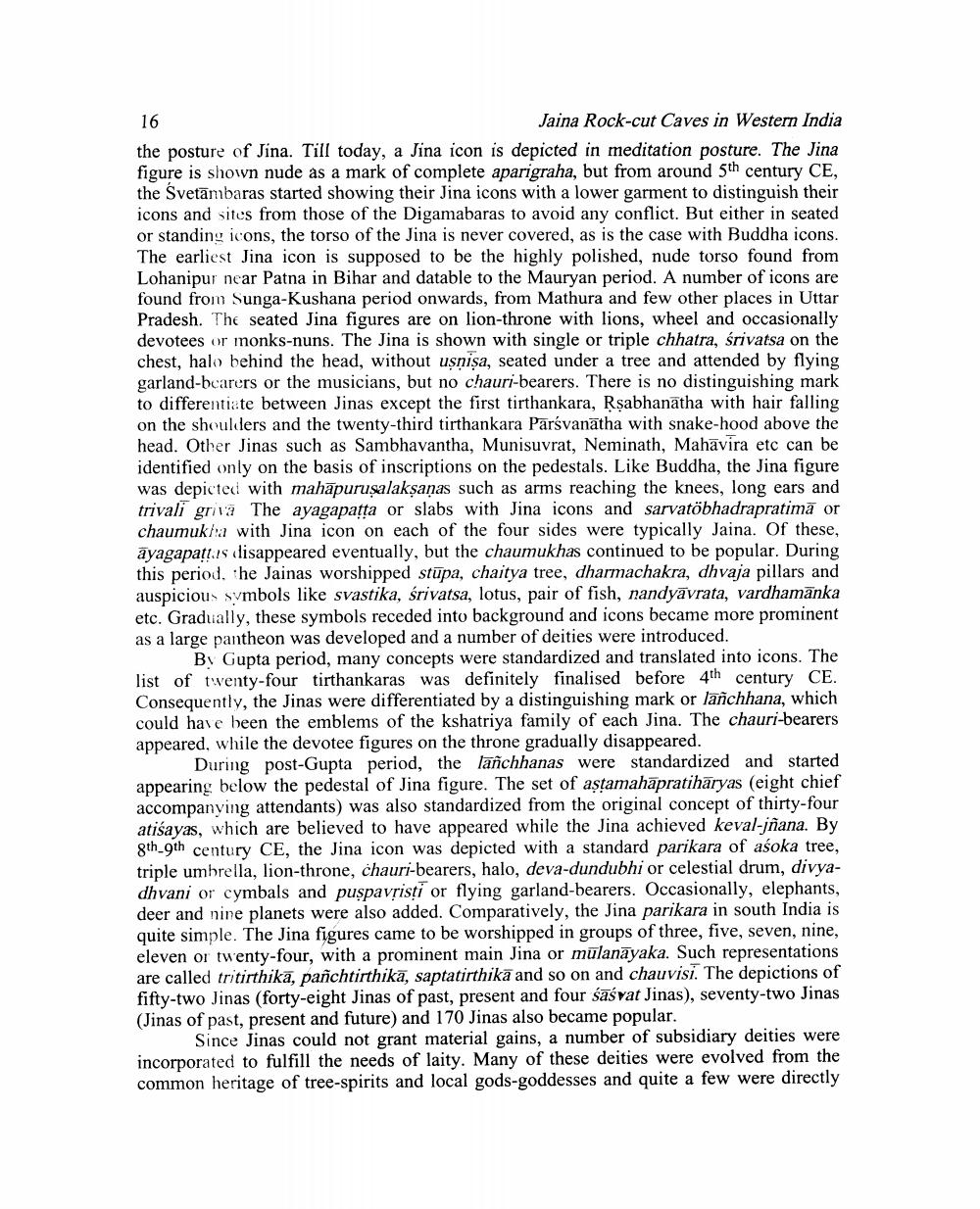________________
16
Jaina Rock-cut Caves in Western India the posture of Jina. Till today, a Jina icon is depicted in meditation posture. The Jina figure is shown nude as a mark of complete aparigraha, but from around 5th century CE, the Svetambaras started showing their Jina icons with a lower garment to distinguish their icons and sites from those of the Digamabaras to avoid any conflict. But either in seated or standing icons, the torso of the Jina is never covered, as is the case with Buddha icons. The earliest Jina icon is supposed to be the highly polished, nude torso found from Lohanipur near Patna in Bihar and datable to the Mauryan period. A number of icons are found from Sunga-Kushana period onwards, from Mathura and few other places in Uttar Pradesh. The seated Jina figures are on lion-throne with lions, wheel and occasionally devotees or monks-nuns. The Jina is shown with single or triple chhatra, śrivatsa on the chest, halo behind the head, without uşnişa, seated under a tree and attended by flying garland-bearers or the musicians, but no chauri-bearers. There is no distinguishing mark to differentiate between Jinas except the first tirthankara, Rsabhanatha with hair falling on the shoulders and the twenty-third tirthankara Parsvanātha with snake-hood above the head. Other Jinas such as Sambhavantha, Munisuvrat, Neminath, Mahavira etc can be identified only on the basis of inscriptions on the pedestals. Like Buddha, the Jina figure was depicted with mahāpurusalaksaņas such as arms reaching the knees, long ears and trivali griva The ayagapatta or slabs with Jina icons and sarvatöbhadrapratimă or chaumukha with Jina icon on each of the four sides were typically Jaina. Of these, ayagapatts disappeared eventually, but the chaumukhas continued to be popular. During this period, the Jainas worshipped stūpa, chaitya tree, dharmachakra, dhvaja pillars and auspicious symbols like svastika, srivatsa, lotus, pair of fish, nandyāvrata, vardhamanka etc. Gradually, these symbols receded into background and icons became more prominent as a large pantheon was developed and a number of deities were introduced.
By Gupta period, many concepts were standardized and translated into icons. The list of twenty-four tirthankaras was definitely finalised before 4th century CE. Consequently, the Jinas were differentiated by a distinguishing mark or lañchhana, which could have been the emblems of the kshatriya family of each Jina. The chauri-bearers appeared, while the devotee figures on the throne gradually disappeared.
During post-Gupta period, the lañchhanas were standardized and started appearing below the pedestal of Jina figure. The set of astamahāpratiharyas (eight chief accompanying attendants) was also standardized from the original concept of thirty-four atiśayas, which are believed to have appeared while the Jina achieved keval-jñana. By gth_9th century CE, the Jina icon was depicted with a standard parikara of aśoka tree, triple umbrella, lion-throne, chauri-bearers, halo, deva-dundubhi or celestial drum, divyadhvani or cymbals and puspavristi or flying garland-bearers. Occasionally, elephants, deer and nine planets were also added. Comparatively, the Jina parikara in south India is quite simple. The Jina figures came to be worshipped in groups of three, five, seven, nine, eleven or twenty-four, with a prominent main Jina or mulanāyaka. Such representations are called tritirthika, pañchtirthikā, saptatirthikā and so on and chauvisi. The depictions of fifty-two Jinas (forty-eight Jinas of past, present and four sasvat Jinas), seventy-two Jinas (Jinas of past, present and future) and 170 Jinas also became popular.
Since Jinas could not grant material gains, a number of subsidiary deities were incorporated to fulfill the needs of laity. Many of these deities were evolved from the common heritage of tree-spirits and local gods-goddesses and quite a few were directly




